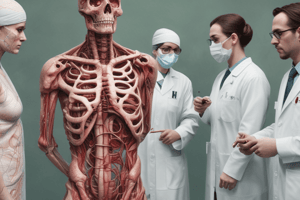Podcast
Questions and Answers
What is the main difference between hospital/non-official autopsy and medico-legal/official autopsy?
What is the main difference between hospital/non-official autopsy and medico-legal/official autopsy?
- Hospital/non-official autopsy requires consent from relatives, while medico-legal/official autopsy is conducted when the dead body belongs to the state for public interest. (correct)
- Hospital/non-official autopsy is conducted for legal purposes, while medico-legal/official autopsy is conducted for medical purposes.
- Hospital/non-official autopsy is conducted when the dead body belongs to the state for public interest, while medico-legal/official autopsy requires consent from relatives.
- Hospital/non-official autopsy is conducted by a medical examiner, while medico-legal/official autopsy is conducted by a forensic pathologist.
What is included in the external examination of an autopsy?
What is included in the external examination of an autopsy?
- A microscopic examination of the blood and urine samples.
- A head-to-toe detailed inspection of the body, noting tattoos, scars, deformities, and injuries, and describing the position of stab or gunshot wounds. (correct)
- A toxicological examination of the organs and tissues.
- A detailed examination of the internal organs and tissues.
What type of incision is made for women during an autopsy?
What type of incision is made for women during an autopsy?
- V incision
- Y incision
- U incision
- T incision (correct)
What is the purpose of saving samples of blood, urine, organs, and tissues during an autopsy?
What is the purpose of saving samples of blood, urine, organs, and tissues during an autopsy?
What is the purpose of the provisional anatomic diagnoses section of the autopsy report?
What is the purpose of the provisional anatomic diagnoses section of the autopsy report?
What does a provisional death certificate indicate?
What does a provisional death certificate indicate?
What is the purpose of the U incision during an autopsy?
What is the purpose of the U incision during an autopsy?
What happens to the organs and tissues after they are examined during an autopsy?
What happens to the organs and tissues after they are examined during an autopsy?
When is a medico-legal/official autopsy conducted?
When is a medico-legal/official autopsy conducted?
What does a provisional death certificate with 'circumstances pending police investigation (CPPI)' indicate?
What does a provisional death certificate with 'circumstances pending police investigation (CPPI)' indicate?
What is the purpose of a hospital/non-official autopsy?
What is the purpose of a hospital/non-official autopsy?
When is medico-legal/official autopsy conducted?
When is medico-legal/official autopsy conducted?
What is included in the external examination of the body during autopsy?
What is included in the external examination of the body during autopsy?
What is the purpose of collecting samples during autopsy?
What is the purpose of collecting samples during autopsy?
What is the purpose of the Y incision during autopsy?
What is the purpose of the Y incision during autopsy?
What is the T incision used for during autopsy?
What is the T incision used for during autopsy?
What is the U incision used for during autopsy?
What is the U incision used for during autopsy?
What happens to the organs and tissues after they are examined during autopsy?
What happens to the organs and tissues after they are examined during autopsy?
What is included in the provisional anatomic diagnoses section of the autopsy report?
What is included in the provisional anatomic diagnoses section of the autopsy report?
What does a provisional death certificate indicate?
What does a provisional death certificate indicate?
Study Notes
Types and Procedures of Autopsy
- Autopsies are conducted for two main purposes: hospital/non-official autopsy for medical purposes and medico-legal/official autopsy for legal purposes.
- Hospital/non-official autopsy requires consent from relatives, while medico-legal/official autopsy is conducted when the dead body belongs to the state for public interest.
- The external examination in autopsy includes a head-to-toe detailed inspection of the body, noting tattoos, scars, deformities, and injuries, and describing the position of stab or gunshot wounds.
- All findings in autopsy are documented in a final written report and photographs with a ruler and label for identification.
- Autopsy incisions include Y incision for men, T incision for women, and U incision for forensic pathology, which focuses on the muscles of the neck and the hyoid bone.
- After the incisions, the neck organs, muscles, and the ribcage are examined and dissected, and the chest cavity is exposed for examination.
- Samples of blood, urine, organs, and tissues are collected and saved for toxicological and microscopic examination.
- The organs and tissues are returned to the body cavity and the incisions are sutured.
- The forensic pathologist lists all findings in a provisional anatomic diagnoses section of the autopsy report.
- If the cause and manner of death are readily apparent, these can be listed in the autopsy report and on the death certificate.
- If the cause and manner of death are not immediately apparent, the forensic pathologist will sign a provisional death certificate as either "pending further studies" or "pending further studies and police investigation."
- If the cause of death is apparent, the forensic pathologist may sign the death certificate and add "circumstances pending police investigation (CPPI)" for unknown circumstances.
Studying That Suits You
Use AI to generate personalized quizzes and flashcards to suit your learning preferences.
Description
Test your knowledge on the types and procedures of autopsy with this informative quiz. From hospital/non-official autopsy to medico-legal/official autopsy, learn about the different purposes and requirements for conducting an autopsy. Explore the external examination process, autopsy incisions, and the dissection of organs and tissues. This quiz also covers the documentation of findings and the provisional anatomic diagnoses section of the autopsy report. Sharpen your understanding of autopsy procedures and terminology with this quiz.




